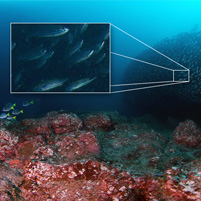Gigapixel Show

It's literally science like you've never seen.
A "bait ball" of Salema fish swirling off the Galapagos Islands. One of the world's largest penguin colonies basking on an Antarctic beach. Ancient petroglyphs in northern Saudi Arabia depicting hunters and their prey.
These are just three of the arresting scientific panoramas selected for a juried gallery show in conjunction with the Fine International Conference on Gigapixel Imaging for Science.
Each of the eight giant images selected for the show — which will be unveiled at Carnegie Museum of Natural History when the scientific conference begins in Pittsburgh Nov. 11 — is a very high-resolution image created by combining tens or hundreds of individual digital photos.
Combined, the eight images include almost 4 billion pixels — or enough to fill 10 billboards at standard resolution, said Illah Nourbakhsh, associate professor of robotics at Carnegie Mellon University and general co-chair of the Fine Conference.
On a computer screen, these rich, high-resolution images can be explored interactively. In the gallery show the images will be exhibited as prints 4 feet high and up to 17 feet wide. The prints will be on display to the public through the end of the year.
"Standing a couple of feet from one of these huge prints feels like being taken to another place — your field of view is covered by imagery as detailed as your eyes can possibly see," said Randy Sargent, a scientist at Carnegie Mellon and the NASA Ames Research Center who is a general co-chair of the Fine Conference. "It was very difficult for the team to select among the submissions — these scientists have some very important and compelling places to take us."
The conference, sponsored by the Fine Foundation of Pittsburgh and hosted by Carnegie Mellon Nov. 11-13, is the first scientific meeting exploring the use of new technologies for producing gigantic electronic images, such as the GigaPan camera system developed by Carnegie Mellon and NASA.
These technologies are being used by scientists across such disciplines as primatology, archaeology and entomology to monitor and document field sites, to study and share artifacts and to educate students and the general public about science.
"GigaPan is an excellent tool for documenting ancient rock art," said Sandra L. Olsen, curator of anthropology at Carnegie Museum of Natural History, whose petroglyph project is part of the gallery show. "Because it combines a large format with extremely high resolution, the archaeologist can build a database that is not only of great use in his or her analysis, but can also be transmitted to other scholars who do not have an opportunity to visit such remote sites themselves."
Mark Bauman, executive vice president of National Geographic Television, will be among the keynote speakers at the event. In addition to the print show at Carnegie Museum of Natural History, the images also can be explored at www.gigapan.org.
Pictured above is a jpeg image of a Galapagos Bait Ball of Salema, by Jason Buchheim of Odyssey Expeditions.
Related Links: Read More | Register for Conference | Twitter: Fine Outreach for Science
